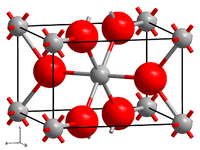Nickel (II) fluoride
| Crystal structure | ||||||||||||||||
|---|---|---|---|---|---|---|---|---|---|---|---|---|---|---|---|---|

|
||||||||||||||||
| __ Ni 2+ __ F - | ||||||||||||||||
| General | ||||||||||||||||
| Surname | Nickel (II) fluoride | |||||||||||||||
| other names |
Nickel difluoride |
|||||||||||||||
| Ratio formula | NiF 2 | |||||||||||||||
| Brief description |
yellow, crystalline solid (pure substance) |
|||||||||||||||
| External identifiers / databases | ||||||||||||||||
|
||||||||||||||||
| properties | ||||||||||||||||
| Molar mass | 96.69 g mol −1 | |||||||||||||||
| Physical state |
firmly |
|||||||||||||||
| density |
4.7 g cm −3 |
|||||||||||||||
| Melting point |
1450 ° C |
|||||||||||||||
| solubility |
25.6 g l −1 in water (25 ° C) |
|||||||||||||||
| safety instructions | ||||||||||||||||
|
||||||||||||||||
| As far as possible and customary, SI units are used. Unless otherwise noted, the data given apply to standard conditions . | ||||||||||||||||
Nickel (II) fluoride is a chemical compound of the elements nickel and fluorine . The pure substance is a yellow, very hygroscopic, crystalline solid that melts at 1000 ° C. Nickel (II) fluoride trihydrate, NiF 2 · 3 H 2 O, and nickel (II) fluoride tetrahydrate, NiF 2 · 4 H 2 O exist as further forms .
Extraction and presentation
Nickel (II) fluoride can be synthesized from the elements at higher temperatures:
- Nickel and fluorine react in a molar ratio of 1: 1 at 550 ° C to form nickel (II) fluoride.
The reaction of nickel with hydrofluoric acid is also possible :
Another possibility is the reaction of nickel (II) chloride with fluorine at 350 ° C, whereby the chloride ions are oxidized to chlorine :
properties
Physical Properties
Nickel (II) fluoride crystallizes in the tetragonal crystal system with the space group P 4 2 / mnm (space group no.136) and the lattice parameters a = 465.08 pm and c = 308.37 pm, in the unit cell there are two formula units .
Nickel (II) fluoride tetrahydrate crystallizes in the orthorhombic crystal system with the space group P 2 1 from (space group no. 29, position 3) and the lattice parameters a = 798.5 pm, b = 1248.2 pm and c = 572 pm , There are four formula units in the unit cell .
Chemical properties
Contact with mineral acids produces highly toxic hydrogen fluoride , here nitric acid as an example :
The dehydration and decomposition of nickel (II) fluoride tetrahydrate takes place in several stages. At 125 ° C, three molecules of water are released, the monohydrate NiF 2 · H 2 O is formed. At 225 ° C, water and hydrogen fluoride are split off and an intermediate product with the stoichiometric composition NiOHF · 3NiF 2 is formed . After another molecule of hydrogen fluoride is split off at 430 ° C, a mixture of nickel (II) oxide and nickel (II) fluoride remains in an anhydrous atmosphere , otherwise the end product is pure nickel (II) oxide.
Complexes
Nickel (II) fluoride forms tetrafluorocomplexes with fluorides :
This tetrafluoro complexes have a layered structure in which NiF 6 - octahedra are linked.
Individual evidence
- ↑ a b webelements.com: Nickel (II) fluoride
- ^ A b c Norman N. Greenwood, Alan Earnshaw: Chemistry of the elements. 1st edition, Wiley-VCH, Weinheim 1988, ISBN 3-527-26169-9 .
- ↑ David R. Lide (Ed.): CRC Handbook of Chemistry and Physics . 90th edition. (Internet version: 2010), CRC Press / Taylor and Francis, Boca Raton, FL, Physical Constans of Inorganic Compounds, pp. 4-77.
- ↑ a b Entry on nickel difluoride in the GESTIS substance database of the IFA , accessed on February 1, 2016(JavaScript required) .
- ↑ Entry on nickel difluoride in the Classification and Labeling Inventory of the European Chemicals Agency (ECHA), accessed on February 1, 2016. Manufacturers or distributors can expand the harmonized classification and labeling .
- ↑ a b c d e A. F. Holleman , E. Wiberg , N. Wiberg : Textbook of Inorganic Chemistry . 102nd edition. Walter de Gruyter, Berlin 2007, ISBN 978-3-11-017770-1 , p. 1713.
- ^ A b c Jean D'Ans, Ellen Lax: Pocket book for chemists and physicists. 3. Elements, inorganic compounds and materials, minerals, Volume 3. 4. Edition, Springer, 1997, ISBN 978-3-540-60035-0 , p. 640 ( limited preview in Google book search).
- ↑ Data sheet nickel (II) fluoride from AlfaAesar, accessed on December 15, 2010 ( PDF )(JavaScript required) .
- ^ BA Lange, HM Haendler: The thermal decomposition of nickel and zinc fluoride tetrahydrates . In: Journal of Inorganic and Nuclear Chemistry 1973 , 35 (9), pp. 3129-3133. doi : 10.1016 / 0022-1902 (73) 80010-7
- ^ AF Holleman , E. Wiberg , N. Wiberg : Textbook of Inorganic Chemistry . 102nd edition. Walter de Gruyter, Berlin 2007, ISBN 978-3-11-017770-1 , p. 1756.








